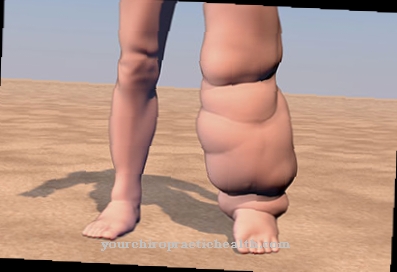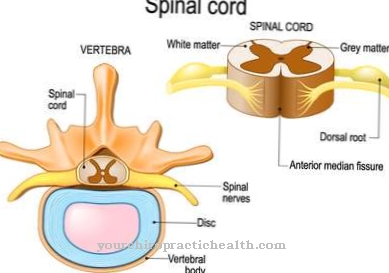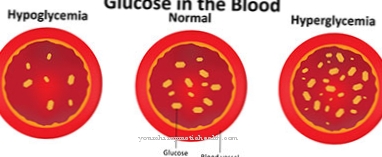Ataxias are disorders of movement coordination, for which different diseases are the trigger. There is a loss of function of certain parts of the nervous system. Usually the cerebellum is affected, but damage to the spinal cord or peripheral nerves can also lead to ataxias.
What is ataxia?

© alexeyblogoodf - stock.adobe.com
Ataxia is derived from the Greek word ataxia, which means disorder or irregularity. The term ataxia encompasses various disorders of movement coordination that can manifest themselves in different ways.
Ataxias are classified according to etiology, according to the affected section of the nervous system or according to the type of movement involved. In the latter, a distinction is made between trunk ataxia, standing ataxia, gait ataxia and pointing ataxia. Trunk ataxia sufferers cannot sit or stand straight without support.
In standing ataxia, patients are only able to stand and walk with help. The gait ataxia manifests itself in a wide-legged and unsteady gait. In pointing ataxia, those affected cannot coordinate their movements correctly, which leads to fine motor difficulties such as pointing next to them, excessively extending movements or unnecessary and shaky movements.
If only one half of the body is affected by the ataxia, this is known as hemiataxia. In addition to the impaired coordination of movements, other signs can occur. Speech may be disturbed, eye movements may no longer be coordinated, or problems swallowing. Accompanying symptoms such as incontinence, pain or muscle cramps are often observed.
causes
Diseases with loss of function of certain parts of the nervous system can cause ataxias. The most common cause is damage to the cerebellum, which is responsible for coordinating information from the spinal cord, the organ of equilibrium and the other senses. The cerebellum translates this information into motor movements.
If this no longer works, ataxias develop. Brain tumors or metastases in the cerebellum can lead to the symptoms. A stroke that causes circulatory problems or bleeding in the cerebellum can also trigger ataxia. Inflammatory diseases of the nervous system, in which the cerebellum or spinal cord is damaged, are also possible causes. One example of this is multiple sclerosis.
Infectious diseases such as measles, if severe, can damage nerves and cause ataxia. Acute cerebellar dysfunction due to excessive alcohol consumption or the overdose of certain medications, such as anti-epileptic drugs, benzodiazepines or certain antibiotics, also trigger disorders in movement coordination. Ataxias can also be genetic, the so-called hereditary ataxias. Triggers are various rare, inheritable diseases that usually affect the cerebellum or the spinal cord.
Symptoms, ailments & signs
Clear symptoms and signs of ataxia are gait disorders, coordination disorders, restricted mobility, speech disorders and difficulty swallowing. If a patient suffers from ataxia, he is no longer able to move as usual. In gait ataxia, the movements appear uncertain with a comparatively wide-legged gait.
Because of these shaky and uncoordinated movements, those affected try to compensate for imbalances. Trunk ataxia manifests itself in the inability to sit up straight and an associated tendency to fall to the right or left. In the case of pointing ataxia, complaints arise in the course of fine motor movements.
In addition, showing, extending and excess as well as uncoordinated and shaky movements are the result. In standing ataxia, the person affected is only able to stand and walk with outside help. The ataxia can vary in severity and affect both or only one half of the body.
Due to the multiple complaints, there is also an increased risk of accidents. Due to the disturbed movement sequences, it often happens that those affected not only stumble, but simply fall over. In addition to these musculoskeletal complaints, a loss of control of the eyes is possible, which means that distances and goals are not correctly assessed.
The pronunciation is unclear and difficult to understand, while eating is only possible to a limited extent due to difficulty swallowing. Muscle cramps, pain and incontinence can also occur.
Diagnosis & course
Ataxia can begin gradually or symptoms appear suddenly, depending on the cause. The first signs are difficulties in coordination, uneven gait or frequent stumbling, as well as fine motor difficulties. Problems speaking, loss of control of eye movements, and difficulty swallowing also occur.
In the event of a loss of balance, loss of control of the limbs, spongy speech or difficulty swallowing, those affected should consult a neurologist to clarify the cause. If movement disorders suddenly occur, a doctor should also be contacted immediately.
If the symptoms appear before the age of 25, a molecular genetic test is carried out. This will determine if an inherited condition is causing the symptoms. In adulthood, extensive physical and neurological exams may be required to determine the cause of the disease.
Laboratory tests that examine blood or urine can provide information about other diseases. An x-ray, computed tomography, or spinal fluid collection may also be necessary in some cases. The further course of the symptoms and whether they worsen or regress depends on the causal disease.
Complications
With ataxia, the patient can no longer move properly on their own. In most cases, he or she depends on the help of other people or walking aids in order to be able to walk properly. In the case of ataxia, it can also happen that the affected person can no longer stand alone. The gait appears to be relatively wide-legged and unsteady.
Also, goals and the distance to the goals can no longer be assessed correctly. The patient often goes wrong and cannot easily achieve certain things. Rapid and sudden movements can also usually no longer be carried out. The patient's everyday life is severely restricted by the ataxia and the person is mostly dependent on the help of other people.
In many cases, ataxia is caused by abuse of alcohol or other drugs. Stopping these drugs can prevent their expansion. However, the ataxia will usually not go away completely even if the drugs are stopped. Physiotherapy can also be helpful and encourages movement for the patient. Treatment with medication is not necessary, however.
When should you go to the doctor?
If ataxia is suspected, you should speak to your family doctor quickly. If coordination disorders, gait disorders or other movement restrictions occur all of a sudden that cannot be traced back to any other cause, medical advice is required. Acute speech disorders or swallowing difficulties may also be caused by a disease that needs to be clarified. Stroke patients should speak to their doctor if there are signs of ataxia.
The same applies to people who have already suffered a cerebral haemorrhage or have had measles in the past. Tumors and nerve diseases can also cause ataxia. Patients with a corresponding medical history should therefore definitely have these symptoms examined.
If movement coordination disorders occur after taking a new medication, you should speak to your family doctor before the symptoms worsen. Patients with hereditary ataxias should inform themselves regularly about the possible symptoms and consult a doctor at the first signs. Comprehensive therapy can usually prevent further complications.
Doctors & therapists in your area
Treatment & Therapy
Therapy for ataxia also depends on the underlying disease. In some cases, as the disease is cured, the symptoms of ataxia also go away.
Ataxia caused by measles or viral infections also usually improves on its own. In the event of excessive alcohol consumption or overdosing on medication, avoiding these substances helps to improve the symptoms. Only with chronic alcohol abuse can irreversible damage to movement coordination occur.
In other cases, such as multiple sclerosis, a cure is not possible and permanent restriction can result. Those affected depend on walking sticks or other aids. Movement and speech therapies can be used to support ataxias in order to improve or maintain these skills.
Outlook & forecast
The prognosis of ataxia depends on the underlying disease. With Friedreich's ataxia or a genetic disease such as multiple sclerosis, the prognosis is poor. The course of the disease is progressive and there is a shortening of life. Many patients are dependent on the help of third parties, assistants or a wheelchair to get around.
If there are viral or bacterial infections, there are significantly better prospects for a cure. Once the original condition is cured, the symptoms of ataxia will go away. The muscles and nerves are supplied as usual and the movement can be coordinated without any symptoms.
Most patients can also recover from alcohol, substance abuse, or excessive drug use. As soon as the active ingredients have been completely and permanently removed from the organism, regeneration occurs after a while. The possibilities of movement start as usual and remain.
In the case of a stroke, a heart attack or a tumor in the brain, the prospects for a cure are individual, but still not favorable. With a lot of training to build muscle and movement coordination as well as good medical care and at the same time minor damage, the symptoms can be alleviated. Complete healing is usually not possible.
prevention
Prevention of ataxias is in many cases not possible and depends on the original disease. Avoiding obesity, high blood pressure and normal cholesterol levels and avoiding nicotine lower the risk of a stroke. Refraining from excessive alcohol, drug or medication consumption is also useful.
You can do that yourself
If ataxia is suspected, a doctor must initiate appropriate treatment steps. At the same time, dealing with the disease can be made easier by taking some self-help measures.
First of all, the disease should be diagnosed at the first signs so that treatment can take place at an early stage. As a result, severe secondary symptoms can be avoided in many cases. Movement exercises such as yoga or physiotherapy can help against Parkinson's-like movement disorders and muscle cramps. The accompanying pain can be relieved with painkillers, but also with pain-relieving teas.
Depending on the type of ataxia, massages and saunas can also help relieve the pain. If there are changes in the speaking apparatus, these must be compensated for early on with speech therapy so that good communication is still possible. Accompanying symptoms such as incontinence or difficulty swallowing should be alleviated by appropriate aids, depending on the clinical picture.
Since the disease cannot be completely cured, it must be learned in the long term to deal with the restricted movement. Self-help groups and discussions with friends and family members are recommended for this. In addition, appropriate precautions must be taken to create an environment suitable for the disabled.








.jpg)



















